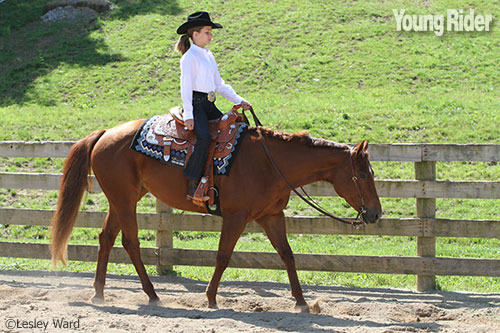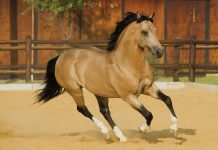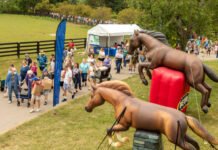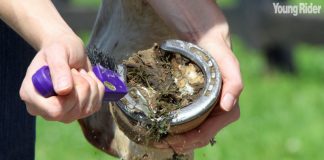If you want to show your horse in western pleasure, it’s important that you understand the class and what the judges are looking for says trainer Missy Jo Hollingsworth of Saddle Lake Equestrian Center, Camp Springs, Ky.
There are no complicated maneuvers in a western pleasure class, and you won’t have to go over or around any obstacles. You simply walk, jog and lope in both directions with a group of other riders in the show pen. An announcer will let you know what gait to pick up and when to change direction. At the end of the class, you’ll be asked to line up with the other riders in the middle of the arena and you may be instructed to back up one at a time under the judge’s watchful eye.
In a western pleasure class, the judge is looking for a horse that looks like he is a pleasure to ride. If the judge wouldn’t want to hop on your horse and lope around the show pen, you’re probably not going to win a ribbon.
According to the American Quarter Horse Association (AQHA) showing rulebook, a good pleasure horse has a free-flowing stride and covers a reasonable amount of ground with little effort. He should be well balanced and his gaits should be consistent with smooth, rhythmic strides—this means his walk, jog and lope looks the same all the way around the show pen—no speeding up or slowing down.
A good western pleasure horse is quiet and well behaved in the show pen. If your horse looks grumpy or tired, you might not place. And your horse should travel on a loose rein with his head level to his withers—not held high in the air or low near the ground—the entire time he’s being judged.
“Take the time to read the rule book,” says Missy. “The judges read the rule book!” So, where’s the rule book? You can find it on the AQHA website at www.aqha.com.

Here are 10 tips to help you become a pro at western pleasure classes.
1. Perfect Position
“Sit up straight in the saddle,” says Missy. “There should be a straight line from your shoulder, hip and heel. Don’t arch your back. Keep your legs long with a slight bend in your knee.”
Make sure your lower legs are not too far forward or too far back.
Here’s an easy way to make sure you’re in the correct position: imagine that if your horse disappeared from underneath you, you’d still land on your feet.
If you hold the reins with your left hand, extend your left arm forward and keep your right arm close to your side.
2. Rein Contact
You’ll lose points in the show pen if your reins are too tight or too loose. Maintain a light contact. Don’t have loopy, loose reins that let your horse sniff the ground and don’t restrict his flowing, forward movement by hanging on his mouth with tight reins. Your horse should have self carriage; this means that he holds his head in the right position without your help.
3. Practice at Home
Work your horse at the walk, jog and lope at home, and practice backing and riding in straight lines and circles.
4. Condition
Although the horse’s performance is important in a western pleasure class, the judge also notes a horse’s conformation and condition. There’s not much you can do about your horse’s conformation; most judges won’t hold your horse’s cow hocks against you if he moves well.
If your horse is packing a few extra pounds, put him on a diet and exercise regime to slim him down. Judges want to see fit horses in the show pen.
5. Ready to Show
Get into your show position about 20 feet before you enter the show pen.
“There’s no fidgeting allowed once you enter the class, “says Missy. “You don’t want to change anything once you go through the gate.”
Remember that you’re being judged the second you enter the arena!
6. Keep the Rhythm
It’s essential that your horse move forward in smooth, rhythmic strides. Missy says to sing the song “London Bridge is Falling Down” to yourself at the jog and lope to help keep your horse’s rhythm steady. “Singing a song will help you tell if your horse is slowing up or speeding up,” says Missy.
7. Stick to the Rail
Ride on the rail and stay on the rail. Maintain a safe distance from the other horses—about two to three horse lengths is ideal if possible. If you must pass a horse, do it on the inside and return to the rail quickly.
8. Get the Gait
When the announcer calls for the jog, ask your horse to jog immediately. Taking an extra step or two in walk when you should be jogging can lose you a ribbon.
“Don’t drag out the transition,” says Missy. “Give the cues quickly and confidently.”
9. Backing Up
When you line up, the judge may ask you to back up. Ask your horse to back up immediately and continue backing until he says “thank you.”
10. Look Ahead
Don’t try to make eye contact with the judge. He’s looking at your horse, not you. Always look up and straight down the rail.





